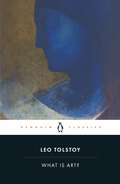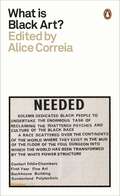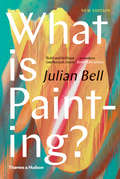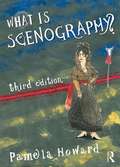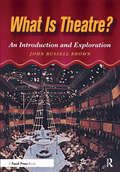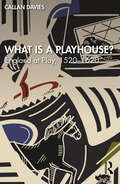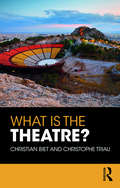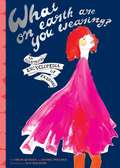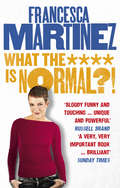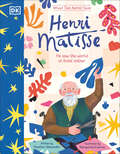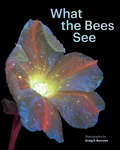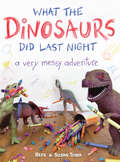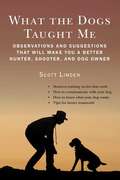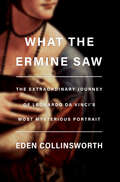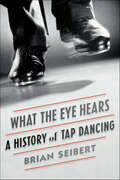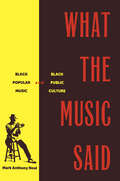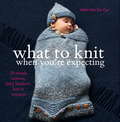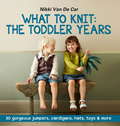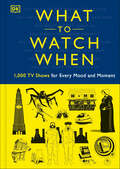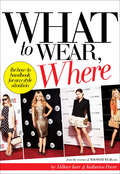- Table View
- List View
What is Art? (Bloomsbury Revelations Ser.)
by Leo TolstoyDuring his decades of world fame as a novelist, Tolstoy also wrote prolifically in a series of essays and polemics on issues of morality, social justice and religion. These works culminated in What is Art?, published in 1898. Impassioned and iconoclastic, this powerfully influential work both criticizes the elitist nature of art in nineteenth-century Western society, and rejects the idea that its sole purpose should be the creation of beauty. The works of Dante, Michelangelo, Shakespeare, Beethoven, Baudelaire and Wagner are all vigorously condemned, as Tolstoy explores what he believes to be the spiritual role of the artist - arguing that true art must work with religion and science as a force for the advancement of mankind.
What is Black Art?
by Alice CorreiaA landmark anthology on British art history, bringing together overlooked and marginalized perspectives from 'the critical decade'What is Black art? This vital anthology gives voice to a generation of artists of African, Asian and Caribbean heritage who worked within and against British art institutions in the 1980s, including Sonia Boyce, Lubaina Himid, Eddie Chambers and Rasheed Araeen. It brings together artists' statements, interviews, exhibition catalogue essays and reviews, most of which have been unavailable for many years and resonate profoundly today. Together they interrogate the term 'Black art' itself, and revive a forgotten dialogue from a time when men and women who had been marginalized made themselves heard within the art world and beyond.
What is Painting? (Revised Edition): New Edition
by Julian BellJulian Bell’s incisive, fully updated study of modern art and the nature of painting, which daringly tries to explain it “Yes, but is it art?” This lucid book by Julian Bell, himself a painter, confronts the uncertainty many people feel about art today and challenges generally accepted ideas. Now in a completely revised second edition, What is Painting? is a fresh, focused look at painting. Bell addresses questions such as “does anything unite those objects we call paintings?” and “what factors have changed the nature of painting over the last two centuries?” by looking at historical evidence and reasoning from common experience. The current shape of painting pushes the book’s arguments in new directions and a substantial new chapter, The Arts and Art, speaks to the interplay between 2D work, 3D work, and the immateriality of digital imagery. The text has been revised paragraph by paragraph considering both force of presentation andr />historical perspective. The intention is to provide a general reader’s introduction to theories of painting that is not only reliably informative but stimulating and amusing to read. The book is an introductory guide to art theory for everyone interested in understanding modern art or in making art themselves.
What is Scenography?
by Pamela Howard"Pamela Howard's ground-breaking What is Scenography? was the first book to set out the bold new approaches to designing and directing for theatre which had dazzled audiences in Europe during the previous decades. It did us all a service by enriching the scope of how we understand the aesthetics of the stage. The lavish new materials (drawings, colour photos, new production analysis) included in this second edition make it even more essential for anyone interested in new developments in theatre." - David Bradby "To write, design, organize, manage, sculpt, educate, paint, research and above all, to passionately live the life of the performance is what Pamela has done throughout her whole career and, in one way or another, it is reflected here in this book: the universality of stage design, its elements and its soul." - Ramon Ivars "Gives an excellent sense of scenography and a window on a life in the theatre - which is fascinating. ...A superb book." - Professor Arnold Aronson, Columbia University, USA "Pamela Howard is the precise definition of what a scenographer of today should be: a multiple artist. Her vast experience with space, her rare and acute power of reflection, her workshops worldwide, her masterful control of drawing and painting and her ability to interconnect scenography with other artistic expressions qualify her to discuss with great authority what "space for staging" should be in the coming decades of this millennium." - Jose Carlos SerroniPamela Howard's What is Scenography? has become a classic text in contemporary theatre design and performance practice. In this second edition, the author expands on her holistic analysis of scenography as comprising space, text, research, art, performers, directors and spectators, to examine the changing nature of scenography in the twenty-first century. The book includes: case studies and anecdotes from Howard's own celebrated career illustrations of her own recent work, in full colour throughout an updated 'world view' of scenography, with definitions from the world's most famous and influential scenographers A direct and personal response to the question of how to define scenography by one of the world's leading practitioners, What is Scenography? continues to shape the work of visual theatremakers throughout the world.
What is Scenography? (Theatre Concepts Ser.)
by Pamela HowardThe third edition of Pamela Howard’s What is Scenography? expands on the author’s holistic analysis of scenography as comprising space, text, research, art, performers, directors and spectators, to examine the changing nature of scenography in the twenty-first century. The book includes new investigations of recent production projects from Howard’s celebrated career, including Carmen and Charlotte: A Tri-Coloured Play with Music, full-colour illustrations of her recent work and updated commentary from a wide spectrum of contemporary theatre makers. This book is suitable for students in Scenography and Theatre Design courses, along with professional theatrical designers.
What is Theatre?: An Introduction and Exploration
by John BrownThis major introductory textbook is from one of the leading educators working in theatre today. What Is Theatre? will make its reader a better playgoer, responding more fully to performance, with a keener appreciation of all the resources of theatre-acting, design, direction, organization, theatre buildings, and audiences. By focusing on the best professional practice and the most helpful learning processes, Dr. Brown shows how to read a play-text and to see and hear its potential for performance. Throughout this book, suggestions are given for student essays and class discussions, to help both instructor and reader to clarify their thoughts on all aspects of theatre-going. While the main focus is on present-day theatre in North America, history is used to illuminate current practice. Theatres in Europe and Asia also feature in the discussion. A view is given of all contributors to performance, with special emphasis placed on actors and the plays they perform. This textbook is not tied to a few specific play-texts, but designed to be effective regardless of which play a student sees or reads. In Part Two, leading practitioners of different generations and cultural backgrounds describe their own work, providing a variety of perspectives on the contemporary theatre. All this is supplemented by nearly 100 black and white and color illustrations from productions, working drawings, and plans. This new text engages its readers in the realities of the theatre; it is up-to-date, comprehensive, and packed with practical advice for understanding how theatre works and how plays come alive in performance. John Russell Brown is professor of Theatre at the University of Michigan, Ann Arbor, and has taught at a variety of colleges including New York and Stanford Universities. For 15 years he was an associate director of the National Theatre in London, and he has directed plays in many other theatres including Cincinnati Playhouse, the Empty Space in Seattle, and the Clurman Theatre in New York. Professor Brown has written extensively about theatre, especially about Shakespeare and contemporary theatre. He is editor of The Oxford Illustrated History of Theatre.
What is a Picture?
by Michael NewallWhat is a picture? Is it a symbol, a likeness, a trigger of certain visual experiences or cognitive states? Each of these ideas, wrongly placed in competition by earlier theorists, gives some insight into what a picture is. This book draws together, criticises and refines these ideas to develop a new theory of pictures, that understands pictures to be an intrinsically visual from of representation. Using an approach deeply informed by art history and perceptual psychology, it explores the ramifications such a theory has for the visual arts, developing a new theory of pictorial realism, reconsidering the special status often granted to perspective-based realism in art, and giving a powerful new analysis of abstraction in modern painting.
What is a Playhouse?: England at Play, 1520–1620
by Callan DaviesThis book offers an accessible introduction to England’s sixteenth- and early seventeenth-century playing industry and a fresh account of the architecture, multiple uses, communities, crowds, and proprietors of playhouses. It builds on recent scholarship and new documentary and archaeological discoveries to answer the questions: what did playhouses do, what did they look like, and how did they function? The book will accordingly introduce readers to a rich and exciting spectrum of "play" and playhouses, not only in London but also around England. The detailed but wide-ranging case studies examined here go beyond staged drama to explore early modern sport, gambling, music, drinking, and animal baiting; they recover the crucial influence of female playhouse owners and managers; and they recognise rich provincial performance cultures as well as the burgeoning of London’s theatre industry. This book will have wide appeal with readers across Shakespeare, early modern performance studies, theatre history, and social history.
What is the Theatre?
by Christian Biet Christophe TriauWhat is the Theatre? is one of the most coherent and systematic descriptions and analyses of the theatre yet compiled. Theatre is, above all, spectacle. It is a fleeting performance, delivered by actors and intended for spectators. It is a work of the body, an exercise of voice and gesture addressed to an audience, most often in a specific location and with a unique setting. This entertainment event rests on the delivery of a thing promised and expected – a particular and unique performance witnessed by spectators who have come to the site of the performance for this very reason. To witness theatre is to take into account the performance, but it is also to take into account the printed text as readable object and a written proposition. In this book, Christian Biet and Christophe Triau focus on the practical, theoretical and historical positions that the spectator and the reader have had in relation to the locations that they frequent and the texts that they handle. They adopt two approaches: analysing the spectacle in its theatrical and historical context in an attempt to seek out the principles and paradigms of approaching the theatre experience on one hand, and analysing the dramaturgy of a production in order to establish lines of interpretation and how to read, represent and stage a text, on the other. This approach allows us to better understand the ties that link those who participate in the theatre to the practitioners who create theatrical entertainment.
What on Earth Are You Wearing?
by Daniel Pollock Chloe QuigleyEvery fashionista worth her Louboutins cares as much about a book's outfit as she does about its content. This purse-sized encyclopedia dons a cloth cover stamped with shimmering silver foil and a satin-ribbon page marker. Alongside vibrant illustrations, a team of fashion forecasters defines more than 285 terms from acid wash to zebra ("fatigues are really just exhausted clothes") and answers sartorial quandaries ("What do I do when I've bought a genuine 'Channel' handbag in Hong Kong?"). Equally snarky and stylish, this insider's guide is sure to be on all of this season's best-dressed lists.
What the **** is Normal?!
by Francesca MartinezIf you grow up in a world where wrinkles are practically illegal, going bald is cause for a mental breakdown, and women over size zero are encouraged to shoot themselves (immediately), what the hell do you do if you’re, gasp … DISABLED? Whatever body you’re born into, the pressure to be normal is everywhere. But have you ever met a normal person? What do they look like? Where do they live? What do they eat for breakfast?And what the **** does normal mean anyway?This is the award-winning wobbly comedian Francesca Martinez’s funny, personal, and universal story of how she learned to stick two shaky fingers up to the crazy expectations of a world obsessed with being ‘normal’.
What the Artist Saw Henri Matisse (What the Artist Saw)
by Heather AlexanderSee the world through Henri Matisse’s eyes and be inspired to produce your own masterpieces.Have you ever wondered exactly what your favorite artists were looking at to make them draw, sculpt, or paint the way they did? In this charming illustrated series of books to keep and collect, you can see what they saw and be inspired to create your own artworks, too. In What the Artist Saw: Henri Matisse, meet the famous French painter and printmaker and learn about his inspiring life and art.A singular look inside the mind of artist Henri Matisse:Follow the life of Henri Matisse and learn about his evolution as an artist, with photographic timelines, informative art reference, and interactive art ideas to try at home yourselfFeatures full-color illustrations that bring the artist’s experiences and creations to lifeA brilliant gift for kids aged 7-9 and young artists who want to learn something new Don’t miss the rest of the What the Artist Saw series!Follow the artists’ stories and find intriguing facts about their environments and key masterpieces. Then see what you can see and make your own art with what you learn. Take a closer look at landscapes, or even yourself, with Vincent van Gogh. Try crafting a story in fabric like Faith Ringgold, or carve a woodblock print at home with Hokusai. Every book in this series is one to treasure and keep – perfect for young artists to explore exhibitions with, then continue their own artistic journeys.
What the Bees See
by Craig P. BurrowsDiscover the magical world of the honeybee with this deluxe book, featuring 70 stunning images shot with ultraviolet technology.A comprehensive look into the amazing science of bees, this book collects mesmerizing ultraviolet-induced visible fluorescence (UVIVF) photography of flowers and nature and offers fascinating research that explores every aspect of our relationship with honeybees. Learn about the history of beekeeping, current environmental impacts affecting bees, and the rise of bee products in medical and wellness spaces. As you travel through the world of bees, you'll discover a diverse range of flora showcased in a whole new light through the ultraviolet spectrum, from orchids and anemones to manuka and cactus blossoms. A gorgeous gift for environmentalists and photography fans alike, this in-depth book invites us to reimagine the world from a bee's point of view and better understand its importance to the future of all life on earth.PHENOMENAL NATURE IMAGERY: Craig P. Burrows has been specializing in UVIVF photography for nearly a decade, and this book includes 70 incredible photos taken using this innovative technique. Burrow's luminescent images capture the magic of nature and showcase flowers glowing in otherworldly blues and teals, simulating how bees and other pollinators become attracted to the plants.GET THE BUZZ ABOUT BEES: In addition to the incredible UV photography, this book features engaging illustrations and infographics, archival and historical images, and original interviews with over forty of the world’s leading experts on bees and bee products. Organized into three distinct sections on bee ecosystems, bee products and cultivation, and modern medical and wellness advances tied to bees, this in-depth book illuminates the extraordinary role the honeybee has played throughout history and will answer questions you didn’t even know you had.SUSTAINABILITY GIFT BOOK: This deluxe photobook is a great gift for nature lovers, bee and beekeeping enthusiasts, and anyone who cares about environmental conservation and preservation. Add it to the shelf with books like the National Geographic Photo Ark series by Joel Sartore and DK's The Bee Book.Perfect for:Bee, insect, and bug enthusiastsNature lovers and environmental activistsFlower and nature photography loversPeople interested in learning about bee products used in medicine, wellness, and skincare People interested in UVIVF technology and innovative photography techniquesFans of nature documentaries like David Attenborough’s Life In Color seriesFans of Craig P. Burrows's research and photography
What the Dinosaurs Did Last Night
by Refe Tuma Susan TumaFrom the parents who brought us the web sensation "Dinovember" comes photographic proof of what toys do at night. Since Toy Story (and maybe since the very first toys!) children and their parents have wondered what it would be like if toys came to life. Refe and Susan Tuma take this wonder several steps further in WHAT THE DINOSAURS DID LAST NIGHT.Every November, writer and social media master Refe Tuma and his wife, Susan, work into the night to bring their four children scenes from the secret lives of their toys -- specifically the nighttime antics of their plastic dinosaurs. The dinosaurs wreck bathrooms, destroy vases, rock out, encounter terrifying hot irons, even do the dishes with hilarious, magical results. Each scene is photographed in meticulous detail, letting viewers joyfully suspend disbelief and think to themselves -- just LOOK what the dinosaurs did last night!
What the Dogs Taught Me: Observations and Suggestions That Will Make You a Better Hunter, Shooter, and Dog Owner
by Scott Linden“My dogs and I get along best when I hit the birds they produce for me. Putting the odds in my favor is the least I can do. Now, so can you.”If you hunt for pheasants, grouse, quail, and other upland birds, forming a partnership with your dog can be a daunting challenge. Wingshooting USA’s Scott Linden is here to help. What the Dogs Taught Me fills in the blanks for the wingshooter and dog owner with solid advice that will improve dog and hunter’s levels of communication, respect, and hunting efficiency.With lessons on dogs’ desires, skills, and abilities to learn, care and feeding, health and safety, preparation, and shooting, What the Dogs Taught Me is the ultimate guide to maximizing happiness and minimizing frustration whether out on the hunt or relaxing in the backyard. Even better, Linden’s lovable, often hilarious tone makes taking advice on training, strategizing, and partnership enjoyable to human and canine alike.Don’t be a student at the school of hard knocks—What the Dogs Taught Me advances an upland hunter’s skills quickly, creatively, and without any of the angst of more difficult methods.
What the Ermine Saw: The Extraordinary Journey of Leonardo da Vinci's Most Mysterious Portrait
by Eden CollinsworthThe remarkable true story behind one of history&’s most enigmatic portraits—"a glorious picaresque of unbridled passions and unmitigated scoundrels, a glorious romp through the great palaces and palazzos of Europe" (Amanda Foreman, New York Times best-selling author of Georgiana, Duchess of Devonshire)Five hundred and thirty years ago, a young woman sat before a Grecian-nosed artist known as Leonardo da Vinci. Her name was Cecilia Gallerani, and she was the young mistress of Ludovico Sforza, duke of Milan. Sforza was a brutal and clever man who was mindful that Leonardo&’s genius would not only capture Cecilia&’s beguiling beauty but also reflect the grandeur of his title. But when the portrait was finished, Leonardo&’s brush strokes had conveyed something deeper by revealing the essence of Cecilia&’s soul. Even today, The Woman with an Ermine manages to astonish. Despite the work's importance in its own time, no records of it have been found for the two hundred and fifty years that followed Gallerani&’s death. Readers of The Hare with the Amber Eyes will marvel at Eden Collinsworth&’s dexterous story of illuminates the eventual history of this unique masterpiece, as it journeyed from one owner to the next–from the portrait&’s next recorded owner, a Polish noblewoman, who counted Benjamin Franklin as an admirer, to its exile in Paris during the Polish Soviet War, to its return to WWII-era Poland where—in advance of Germany&’s invasion—it remained hidden behind a bricked-up wall by a housekeeper who defied Hitler&’s edict that it be confiscated as one of the Reich&’s treasures. Fans of Anne-Marie O&’Connor&’s The Lady in Gold will treasure the story of this criss-crossing journey and the enigmatic woman at its heart. What the Ermine Saw is a fact-based story that cheats fiction and a reminder that genius, power, and beauty always have a price.
What the Eye Hears: A History of Tap Dancing
by Brian SeibertThe first authoritative history of tap dancing, one of the great art forms—along with jazz and musical comedy—created in America.Finalist for the National Book Critics Circle Award in NonfictionWinner of Anisfield-Wolf Book AwardAn Economist Best Book of 2015What the Eye Hears offers an authoritative account of the great American art of tap dancing. Brian Seibert, a dance critic for The New York Times, begins by exploring tap’s origins as a hybrid of the jig and clog dancing and dances brought from Africa by slaves. He tracks tap’s transfer to the stage through blackface minstrelsy and charts its growth as a cousin to jazz in the vaudeville circuits. Seibert chronicles tap’s spread to ubiquity on Broadway and in Hollywood, analyzes its decline after World War II, and celebrates its rediscovery and reinvention by new generations of American and international performers. In the process, we discover how the history of tap dancing is central to any meaningful account of American popular culture.This is a story with a huge cast of characters, from Master Juba through Bill Robinson and Shirley Temple, Fred Astaire and Ginger Rogers, and Gene Kelly and Paul Draper to Gregory Hines and Savion Glover. Seibert traces the stylistic development of tap through individual practitioners and illuminates the cultural exchange between blacks and whites, the interplay of imitation and theft, as well as the moving story of African Americans in show business, wielding enormous influence as they grapple with the pain and pride of a complicated legacy. What the Eye Hears teaches us to see and hear the entire history of tap in its every step.“Tap is America’s great contribution to dance, and Brian Seibert’s book gives us—at last!—a full-scale (and lively) history of its roots, its development, and its glorious achievements. An essential book!” —Robert Gottlieb, dance critic for The New York Observer and editor of Reading Dance“What the Eye Hears not only tells you all you wanted to know about tap dancing; it tells you what you never realized you needed to know. . . . And he recounts all this in an easygoing style, providing vibrant descriptions of the dancing itself and illuminating commentary by those masters who could make a floor sing.” —Deborah Jowitt, author of Jerome Robbins: His Life, His Theater, His Dance and Time and the Dancing Image
What the Fact?: Finding the Truth in All the Noise
by Seema YasminFrom acclaimed writer, journalist, and physician Dr. Seema Yasmin comes a &“savvy, accessible, and critical&” (Kirkus Reviews, starred review) book about the importance of media literacy, fact-based reporting, and the ability to discern truth from lies.What is a fact? What are reliable sources? What is news? What is fake news? How can anyone make sense of it anymore? Well, we have to. As conspiracy theories and online hoaxes increasingly become a part of our national discourse and &“truth&” itself is being questioned, it has never been more vital to build the discernment necessary to tell fact from fiction, and media literacy has never been more important. In this accessible guide, Dr. Seema Yasmin, an award-winning journalist, scientist, medical professional, and professor, traces the spread of misinformation and disinformation through our fast-moving media landscape and teaches young readers the skills that will help them identify and counter poorly-sourced clickbait and misleading headlines.
What the Music Said: Black Popular Music and Black Public Culture
by Mark Anthony NealFirst Published in 1999. Routledge is an imprint of Taylor & Francis, an informa company.
What to Knit When You're Expecting: Simple Mittens, Blankets, Hats And Sweaters For Baby
by Nikki Van De CarNikki Van De Car spent the months before her daughter's birth knitting constantly to keep her hands busy and to help the time before her arrival pass more quickly. She knitted everything from sweaters and hats to burp cloths and stuffed animals. Over the course of the following year, she learned which items were actually useful, and which sat in a drawer, never to be worn. The 28 patterns collected in 'What to Knit When You're Expecting', for babies aged from 0 to 12 months, are the best of these, and include booties, mittens, bibs and blankets, as well as sweaters, hats and cardigans. All are relatively simple, so can be knit while your mind is elsewhere, and all are immensely practical. This title is organized according to where you are in your pregnancy, the patterns for the first trimester reflect the fact there is still plenty of time to finish a longer project; those for the second, when many women learn the sex of their baby, focus on clothes for girls and boys; and projects for the third are quick and easy.
What to Knit When You're Expecting: Simple Mittens, Blankets, Hats And Sweaters For Baby
by Nikki Van De CarNikki Van De Car spent the months before her daughter's birth knitting constantly to keep her hands busy and to help the time before her arrival pass more quickly. She knitted everything from sweaters and hats to burp cloths and stuffed animals. Over the course of the following year, she learned which items were actually useful, and which sat in a drawer, never to be worn. The 28 patterns collected in 'What to Knit When You're Expecting', for babies aged from 0 to 12 months, are the best of these, and include booties, mittens, bibs and blankets, as well as sweaters, hats and cardigans. All are relatively simple, so can be knit while your mind is elsewhere, and all are immensely practical. This title is organized according to where you are in your pregnancy, the patterns for the first trimester reflect the fact there is still plenty of time to finish a longer project; those for the second, when many women learn the sex of their baby, focus on clothes for girls and boys; and projects for the third are quick and easy.
What to Knit: 30 Gorgeous Sweaters, Cardigans, Hats, Toys And More
by Nikki Van De CarToddlers and young children are energetic, curious, enthusiastic - and messy! The 30 patterns in What to Knit the Toddler Years reflect this, allowing you to show their individuality whilst emphasising practicality and comfort, with advice on machine washable yarns. The chapters are divided into Rough & Tumble, which includes a comfy hooded jumper and roomy overalls, Neat & Nice, a lace panel cardigan and a dandelion pullover perfect for visits to Grandma, and Toys & Miscellany, a stuffed octopus, knitted oven gloves for toy kitchens and a ladybird pillow. From over-sized buttons to help tots dress themselves to a playful animal hat, these whimsical and beautiful designs will delight both the young and the young at heart.
What to Knit: The Toddler Years: 30 gorgeous sweaters, cardigans, hats, toys & more
by Nikki Van De CarToddlers and young children are energetic, curious, enthusiastic - and messy! The 30 patterns in What to Knit the Toddler Years reflect this, allowing you to show their individuality whilst emphasising practicality and comfort, with advice on machine washable yarns. The chapters are divided into Rough & Tumble, which includes a comfy hooded jumper and roomy overalls, Neat & Nice, a lace panel cardigan and a dandelion pullover perfect for visits to Grandma, and Toys & Miscellany, a stuffed octopus, knitted oven gloves for toy kitchens and a ladybird pillow. From over-sized buttons to help tots dress themselves to a playful animal hat, these whimsical and beautiful designs will delight both the young and the young at heart.
What to Watch When
by Mark Morris Laura Buller Eddie Robson Christian Blauvelt Andrew Frisicano Stacey Grant Drew Toal Maggie Serota Matthew Turner Laurie UlsterAnswering the eternal question... WHAT TO WATCH NEXT? Looking for a box set to get your adrenaline racing or to escape to a different era? In need of a good laugh to lift your spirits? Hunting for a TV show that the whole family can watch together?If you're feeling indecisive about your next binge-watching session, we've done the hard work for you. Featuring 1,000 carefully curated reviews written by a panel of TV connoisseurs, What To Watch When offers up the best show suggestions for every mood and moment.
What to Wear, Where: The How-to Handbook for Any Style Situation
by Hillary Kerr Katherine Power“Your go-to source for cool, ‘It’ girl style . . . It’s truly relatable for women of all ages, styles, and locations.” —Rachel Zoe, celebrity stylist and bestselling authorLife is stressful; your outfit shouldn’t be. That’s the philosophy behind What to Wear, Where, the second book from the authors of the popular style guide Who What Wear. This time Hillary Kerr and Katherine Power give readers exactly what they’ve asked for: specific advice on how to put together the perfect look for any social occasion. What to Wear, Where addresses more than 50 major social situations, explains what you should wear and what you shouldn’t wear, and shows you exactly what the authors would wear. What to Wear, Where is loaded with practical tips and style suggestions, making it the perfect resource for anyone who wants to feel more confident about her outfit choices. It’s your go-to guide for wardrobe advice and inspiration!“[A] definitive guide to looking trendy and timeless. With style advice for more than fifty special occasions, What to Wear, Where is the ultimate investment piece.” —Harper’s Bazaar“Authors Hillary Kerr and Katherine Power know fashion, and their book, which shares the same name as their style-advising business, WhoWhatWear, offers enlightening insights.” —The Wall Street Journal“WhoWhatWear.com does such a great job of compiling the newest trends. And the founders have a good eye for putting together inspiring clothing combinations.” —Rachel Bilson, actor
